
- Home
- Certification
- Grade
- Item Length
- Material
- Type
- Action Figure (61)
- Armor (29)
- Boot (26)
- Carburetor (184)
- Complete Carburetor (27)
- Complete Carburettor (33)
- Helmet (21)
- Jacket (17)
- Manifold (14)
- Military (11)
- Military -- Aviation (15)
- Model Kit (12)
- Part (12)
- Rc Tank (40)
- Tactical Vest (18)
- Tank (44)
- Throttle Body (43)
- Twin Carburetors (44)
- Twin Carburetors Kit (37)
- Wristwatch (53)
- Other (3196)
- Year Of Issue
Browning Machine Gun 7.92 Israel Army Illustrated Manual Idf 1955 Book
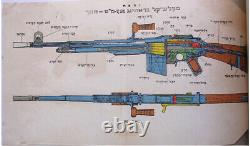
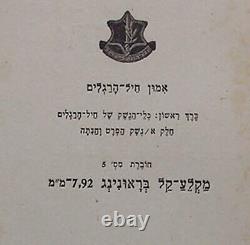
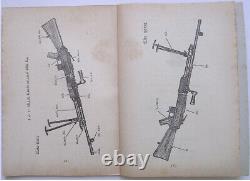
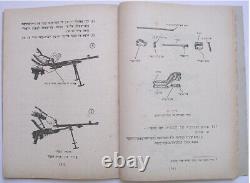
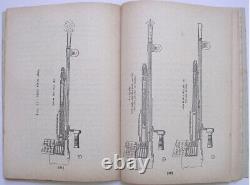


BROWNING MACHINE GUN 7.92 HEBREW MANUAL. A very rare training manual book Browning machine gun caliber 7.92mm, printed by the IDF in February 1955 to teach IDF infantry and paratroopers soldiers to use BROWNING machine gun.
This manual contains 87 pages with many illustrations and fold out color illustration of Browning. Size: 7.5x5.5 inch.
Please have a look at my other listings. The M1919 Browning is a. 30 caliber medium machine gun that was widely used during the 20th century, especially during World War II, the Korean War, and the Vietnam War. The M1919 saw service as a light infantry, coaxial, mounted, aircraft, and anti-aircraft machine gun by the U. The M1919 was an air-cooled development of the standard US machine gun of World War I, the John M.The emergence of general-purpose machine guns in the 1950s pushed the M1919 into secondary roles in many cases, especially after the arrival of the M60 in US Army service. The United States Navy also converted many to 7.62mm NATO, and designated them Mk 21 Mod 0; they were commonly used on river craft in the 1960s and 1970s in Vietnam. Many NATO countries also converted their examples to 7.62, and these remained in service well into the 1990s, as well as up to the present day in some countries. A similar conversion of the M1917 also produced the larger M2 Machine Gun, using the same basic operating principles and layout but firing the much more powerful. 50 caliber (12.7mm) ammunition.
The M1919 is distinguished by its smaller size and the use of a holed jacket around the barrel used on most versions. He M1919 originally fired the. 30-06 ball cartridge, and later the.
30 caliber M2 ball cartridge, contained in a woven cloth belt, feeding from left to right. A metal M1 link was later adopted, forming a "disintegrating" belt. When the gun was ready to fire, a round would be in the chamber and the bolt and barrel group would be locked together, with the locking block at the rear of the bolt.
When the rear of the trigger was pivoted upwards by the operator, the front of the trigger tipped downward, pulling the sear out of engagement with the spring-loaded firing pin, allowing it to move forward and strike the primer of the cartridge. As the assembly of bolt, barrel and barrel extension recoiled to the rear of the gun upon firing, the locking block was drawn out of engagement by a cam in the bottom of the gun's receiver. The recoiling barrel extension struck the "accelerator" assembly, a half-moon shaped spring-loaded piece of metal pivoting from the receiver below the bolt and behind the barrel extension.The tips of the accelerator's two curving fingers engaged the bottom of the bolt and caused it to move rapidly to the rear. The extractor-ejector was a mechanism that pivoted over the front of the bolt, with a claw that gripped the base of the next round in the belt. A camming track in the left side of the receiver caused this to move down as the bolt moved back, lowering the next round down on top of the fired case, pushing it straight down out of the extraction grooves of the bolt face through the ejection port.
A spring in the feed tray cover pushed the extractor-ejector down onto the next round, so if the feed tray cover was opened, the extractor-ejector would be pulled upwards if the belt needed to be removed. The belt feed lever was connected to the belt feeding pawl at the front end, had a cam pin at the rear end which ran through a track in the top of the bolt, and a pin in the feed tray cover acted as the pivot between the two ends.
The rearward movement of the bolt caused the rear end of the feed lever to pull to the right, causing the feeding pawl at the other end to move left over the belt. The pawl would pull the belt further to the right as the bolt came forward again, also sending the loose M1 link of the previous round to be taken out of the belt to fly out the right side of the receiver. A recoil buffer tube extended from the back of the receiver to make the cycle of the bolt smoother than previous designs, to absorb some of the recoil of the bolt, and formed a place for the pistol grip to be installed. Except for the M1919A6, all other variants had to be mounted on a tripod or other type of mount to be used effectively. The tripod used by infantry allowed traverse and elevation.
To aim the gun along its vertical axis, the adjustment screw needed to be operated. This allowed the point of aim to be moved upwards or downwards, with free traverse to either side, allowing the gunner to set an elevation and sweep a wide band of fire across it by simply moving the gun from side to side. There was no need to control barrel climb or keep careful track of the fall of shots to make sure the fire was falling at the proper range.
The gun was aimed using iron sights, a small folding post at the front end of the receiver and a rear aperture sight on a sliding leaf with range graduations from 200 to 1,800 meters in 200 meter increments. When folded down, the aperture formed a notch that could be used to fire the gun immediately without flipping up the leaf. The rear sight also had windage adjustment with a dial on the right side. As a company support weapon, the M1919 required a five-man crew: the squad leader; the gunner (who fired the gun and when advancing carried the tripod and box of ammunition); the assistant gunner (who helped feed the gun and carried it, and a box of spare parts and tools); two ammunition carriers. [2] The original idea of the M1919 was to allow it to be more easily packed for transport, and featured a light barrel and bipod when first introduced as the M1919A1.
Unfortunately, it quickly became clear that the gun was too heavy to be easily moved, while at the same time, too light for sustained fire. This led to the M1919A2, which included a heavier barrel and tripod, and could sustain fire for longer periods.The M1919A4 weighed about 31 pounds (14 kg), and was ordinarily mounted on a "lightweight" (14lb), low-slung tripod for infantry use (light and low compared to the previous M1917 tripod). Fixed vehicle mounts were also employed. It saw wide use in World War II mounted on jeeps, half-tracks, armored cars, tanks, amphibious vehicles, and landing craft. The M1919A4 played a key role in the firepower of the World War II U. Each infantry company normally had a weapons platoon in addition to its other organic units.
The presence of M1919A4 weapons in the weapons platoon gave company commanders additional automatic fire support at the company level, whether in the assault or on defense. [3] The M1919A5 was an adaptation of the M1919A4 with a forward mounting point to allow it to be mounted in tanks and armored cars. This, along with the M37 (another M1919 variant) and the Browning M2 machine gun, was the most common secondary armament during World War II for the Allies.
The coaxial M37 variant had the ability to feed from either the left or the right of the weapon, and featured an extended charging handle similar to those on the M1919A4E1 and A5. A trial variant fitted with special sighting equipment was designated M37F. Another version of the M1919A4, the M1919A6, was an attempt to make the weapon into a true light machine gun by attaching a bipod, buttstock, carrying handle, and lighter barrel 4 lb (1.8 kg) instead of 7 lb (3.2 kg). The M1919A6, with a wooden buttstock, handle, pistol grip and bipod directly mounted to the body of the weapon was in fact one pound heavier than the M1919A4 without its tripod, at 32 lb (15 kg), though its bipod made for faster deployment and enabled the machine gun team to dispense with one man (the tripod bearer).[4] The A6 version saw increasing service in the latter days of World War II and was used extensively in Korea. While the modifications were intended to make the weapon more useful as a squad light machine gun, it was a stopgap solution. Even though it was reliable, it proved somewhat impractical for its intended role.
[5] In the late 1950s, an M1919 designed for remote firing via a solenoid trigger was developed for use in the XM1/E1 armament subsystem was designated M37C. The US Navy later converted a number of M1919A4s to 7.62mm NATO chambering and designated them Mk 21 Mod 0; some of these weapons were employed in Vietnam in riverine warfare patrols. He original M1919 was designed for use with tanks. [10] The water-cooled M1917 was inappropriate due to weight and the vulnerability of the water jacket.Browning modified the M1917 to be air-cooled by making changes that included dropping the water jacket and using a heavier barrel. [10] In total, there were six variants of the basic M1919 machine gun. M1919A1 The M1919A1 featured a lighter barrel and a bipod. It was distinguished from the "M1919" because it also had sights, which the M1919 did not.
M1919A2 The M1919A2 was another lightweight development specifically for mounted cavalry units, utilizing a shorter 18-inch barrel and a special tripod, though it could be fitted to either the M1917 or M2 tripods. This weapon was designed to allow greater mobility to cavalry units over the existing M1917 machine gun. The M1919A2 was introduced in 1922, and was used for a short period between World War I and World War II after the cavalry had converted from horses to wheeled and tracked vehicles.
However, by and large the most common variant of the series was the M1919A4. Production blueprints of the new variant were complete in late 1936, and slow-scale production soon followed. [11] The driving force behind the development of this variant was the lack of reliability in the previous 18-inch barrel versions, which did not produce enough recoil to cycle the action reliably.The gun was given a heavier "bull barrel", much thicker and was lengthened to 24 inches like the M1917, for cooling purposes, and a recoil booster to enhance cycling performance, even with the heavier barrel. Various other small adjustments to the design were made, such as moving the front sight from the barrel jacket to the receiver, which made it easier to mount the gun on vehicles. The design of the barrel jacket was changed to include circular holes instead of long slits of earlier models, and a recoil booster in the muzzle end improved reliability.
The recoil buffer assembly was also a new addition to the design between A3 and A4 development, designed to reduce the impact of the bolt hitting the backplate. The M1919A4 was used in both fixed and flexible mounts, by infantry and on vehicles. It was also widely exported after World War II and continues to be used in small numbers around the world. Two variants were developed specifically for vehicular use, the M1919A5, with an extended charging handle, and the M1919A4E1, a sub-variant of the M1919A4 refitted with an extended charging handle developed in the 1950s During the war it became clear to the US military that the M1918 Browning Automatic Rifle, while portable, was not sufficient as a sustained fire weapon due to its fixed barrel and 20-round magazine.
The M1919A4 was faster and cheaper to produce, but did not have the portability of a rifle. Realizing that producing an entirely new replacement machine gun would take time, the military decided that a stop-gap solution would be best and adapted an existing design.
The M1919A6 was an attempt at such a solution, to parallel the designs of the German MG 34 and MG 42 machine guns, each of which were portable for a squad weapon and were effective at sustained fire. The M1919A6 first saw combat service in the fall of 1943. It had a metal buttstock assembly that clamped to the backplate of the gun, and a front barrel bearing that incorporated both a muzzle booster and a bipod similar to that used on the BAR. A lighter barrel than that of the M1919A4 was fitted, and a carrying handle was attached to the barrel jacket to make it easier to carry. Previous M1919 designs could change the barrel, but it required essentially field stripping the gun to pull the barrel out from the rear the pistol grip back plate, bolt group and the trigger group all had to be removed before the barrel could be replaced, and this put the gun out of action for minutes, and risked losing and damaging parts in the field. The M1919A6 muzzle device allowed the gun crew to replace the barrel from the front; an improvement, but still an awkward procedure compared to other machine guns of the day. The M1919A6 was a heavy 32 pounds (15 kg) and awkward weapon in comparison with the MG34 26 pounds (12 kg) and MG42 25 pounds (11 kg) and was eventually replaced in US service by the M60 machine gun 23.15 pounds (10.50 kg) in the 1960s. The item "BROWNING MACHINE GUN 7.92 ISRAEL ARMY ILLUSTRATED MANUAL IDF 1955 BOOK" is in sale since Thursday, August 15, 2019. This item is in the category "Collectibles\Militaria\Other Militaria". The seller is "levant-fair" and is located in Rishon Lezion. This item can be shipped worldwide.- Country/Region of Manufacture: Israel
- Type: Book

